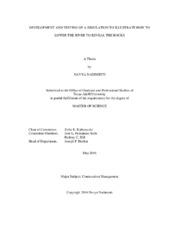| dc.description.abstract | Toyota’s chief engineer Taiichi Ohno urged organizations to “lower the river to reveal the rocks” as a way to identify buffers of time, capacity, inventory, and money. The concept is to temporarily stress a system so that sources of variation hidden by buffers can be made apparent and addressed. The question this research asked was: How might one more effectively communicate Ohno’s principle? The purpose of the paper was to develop and test a 50-minute simulation that uses modest and inexpensive materials to help lean construction educators and facilitators clearly convey the Ohno principle as a means for continuous improvement. For research method employed, a simulation was developed and tested as a first run study, and preliminary results and participant experiences analyzed to hone the simulation toward its final form. The simulation was tested on construction science students, and data from results of the simulation analyzed. It was found that the stress levels experienced decreased, and the perceived efficiency increased once the rocks were identified and removed. The simulation was also found to be effective in demonstrating the process of “lowering the river to reveal the rocks”. One limitation of this research is that its scope is confined to reduction of time buffers - i.e. it does not consider other critical buffers as well. However the intent is to offer a launching point from which discussions with participants about applicability to their delivery processes can emerge. The simulation also offers the potential to serve as a base onto which additional stressors can be subsequently added and tested. Despite the pursuit of continuous improvement by lean construction practitioners, there is still a lack of awareness of how reduction of buffers can highlight opportunities for improvement. The intended implication and value of this work is that the developed simulation can be used to teach the Ohno philosophy to construction management students in academic settings, as well as to lean construction practitioners and stakeholders who may benefit from the inclusion of lean thinking in their practices. | en |


